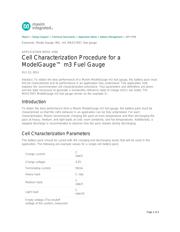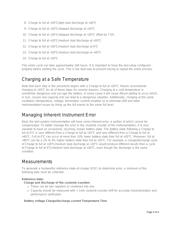herunterladen

Maxim > Design Support > Technical Documents > Application Notes > Battery Management > APP 4799
Keywords: Model Gauge, MG, m3, MAX17047, fuel gauge
APPLICATION NOTE 4799
Cell Characterization Procedure for a
ModelGauge™ m3 Fuel Gauge
Oct 12, 2011
Abstract: To obtain the best performance of a Maxim ModelGauge m3 fuel gauge, the battery pack must
first be characterized and its performance in an application fully understood. This application note
explains the recommended cell-characterization procedure. Test parameters and definitions are given,
and the data necessary to generate a trustworthy reference state of charge (SOC) are listed. The
MAX17047 ModelGauge m3 fuel gauge serves as the example IC.
Introduction
To obtain the best performance from a Maxim ModelGauge m3 fuel gauge, the battery pack must be
characterized so that the cell's behavior in an application can be fully understood. For each
characterization, Maxim recommends charging the pack at room temperature and then discharging the
pack at heavy, medium, and light loads at cold, room (ambient), and hot temperatures. Additionally, a
stepped discharge is recommended to observe how the pack relaxes during discharging.
Cell Characterization Parameters
The battery pack should be cycled with the charging and discharging levels that will be used in the
application. The following are example values for a single-cell battery pack.
Charge current:
C
rate/2
Charge voltage: 4.2V
Terminating current: 50mA
Heavy load: C rate
Medium load:
C
rate/3
Light load:
C
rate/10
Empty voltage (The shutoff
voltage of the system, measured
Page 1 of 4






